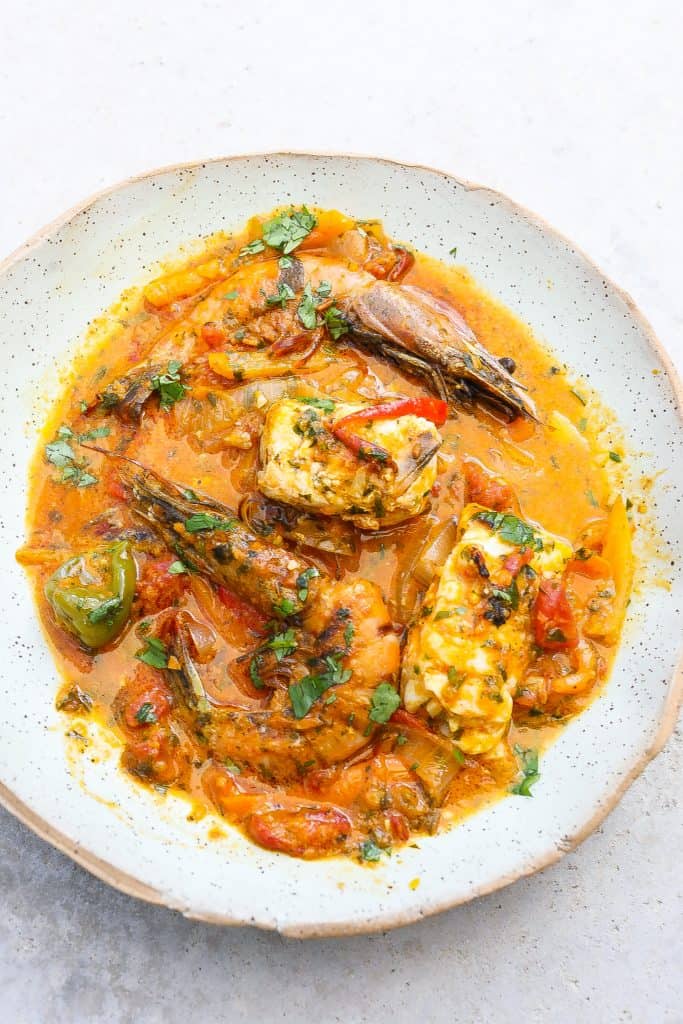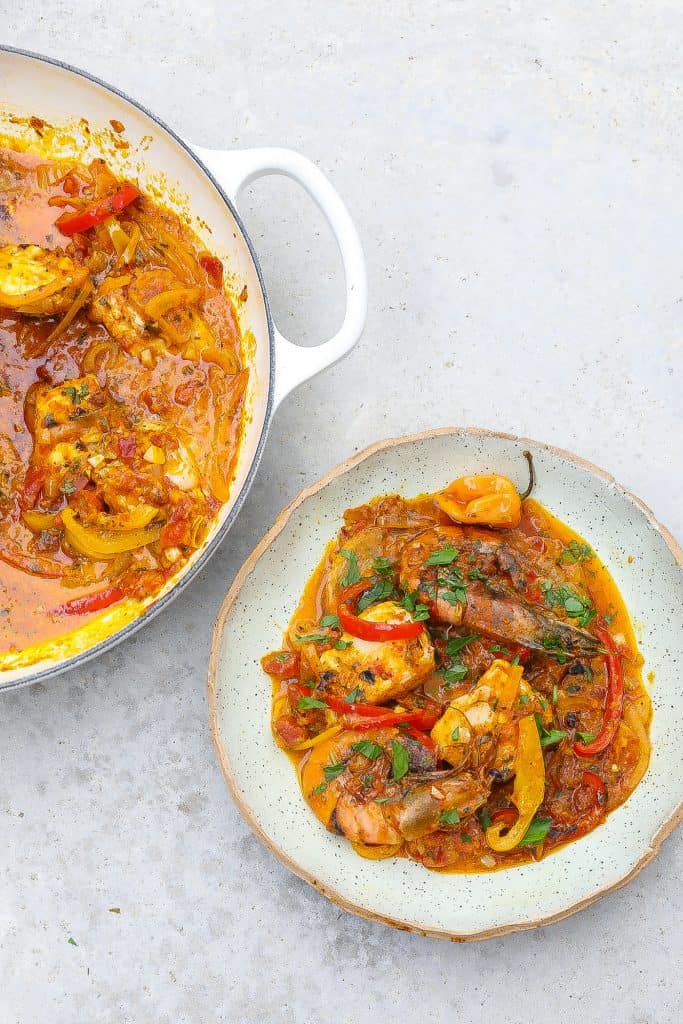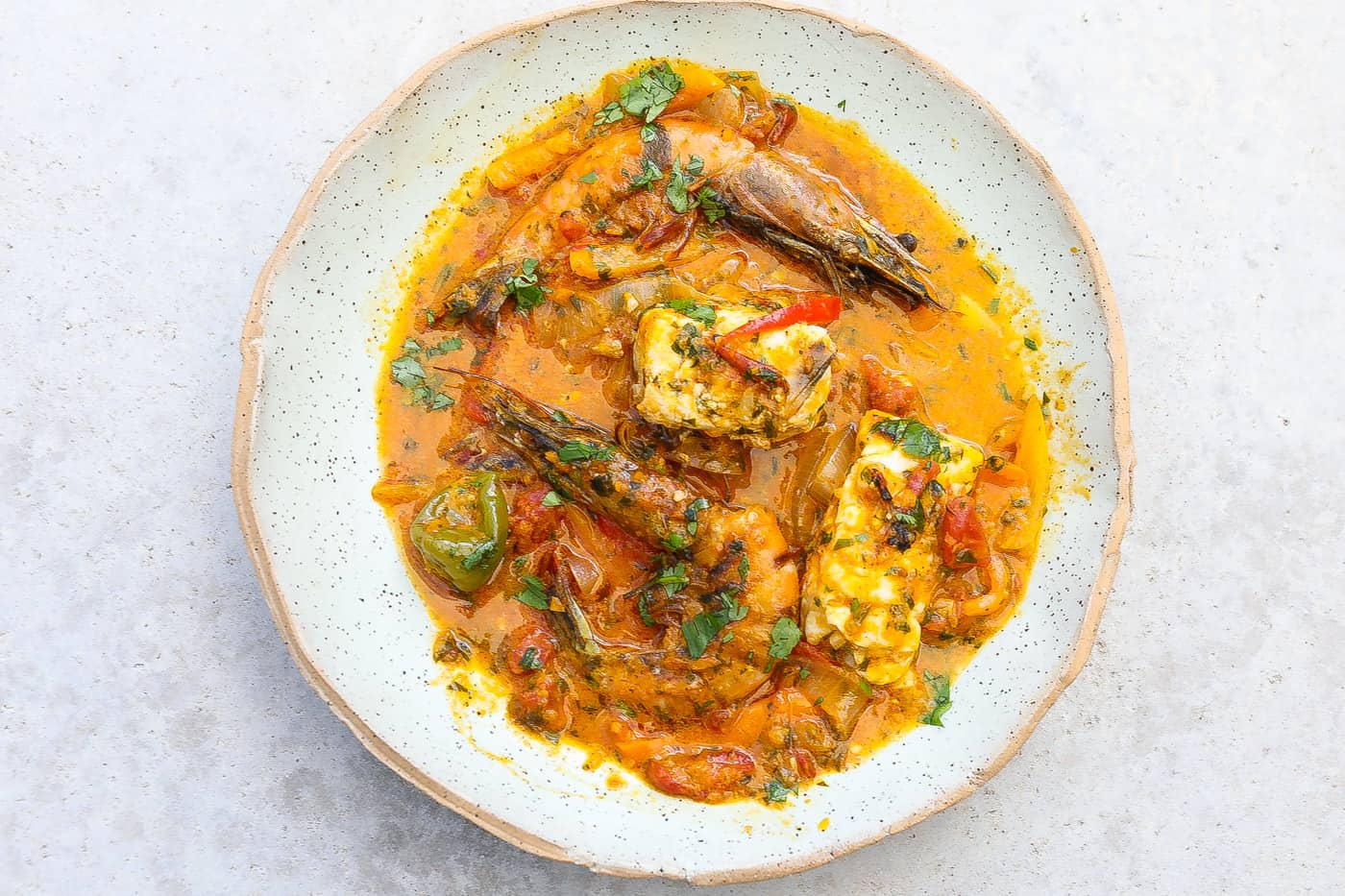This Moqueca aka Brazilian fish stew is a rich, creamy curry-like fish stew made with shrimp that is perfect for a festive holiday dinner or a Sunday dinner change-up.
The seafood is slowly simmered in the most amazing broth that the fish and shrimp flavors add to. Garlic, onions, and bell peppers are the building blocks of the dish but it's the coconut milk and red palm oil give this version its character.
Both ingredients (the palm oil and coconut milk) are distinctly Afro-centric so not surprisingly, this version is familiar in the Bahia region. Bahia was central to the Brazilian slave trade which has resulted in a huge black Brazilian presence.
I've traveled to South America on a few different occasions and each time I was struck with how closely linked black people in the respective regions were to Africa. There just isn't the same level of assimilation you see in the U.S. African rituals and culture are on prominent display in places like Brazil and Columbia, countries hugely impacted by the African slave trade.
I'll detail my trip to Colombia in a later post, particularly its classic fish stew Cazuela de Mariscos. This post is all about moqueca baiana, not to be confused with moqueca de Capixaba.

Beats and Eats Pairing
Tim Maia's "Que Beleza" makes for the perfect song pairing to Moqueca. "Beleza" translated to English means beauty, but as slang depending on context can have different interpretations from "how beautiful" to "awesome." The song itself is bass-heavy, fun, and super funky which is also how I would describe this moqueca. It's also deeply soulful and when you taste good moqueca you can definitely taste it.
What is moqueca?
Moqueca is a fish stew and basically one of the national dishes of Brazil along with couve mineira aka Brazilian collard greens. Bahia and Capixaba represent the two regional versions of moqueca.
What is the difference between moqueca baiana and the Capixaba version?
Both are seafood-based, but besides this, they differ in major ways owing to regional and cultural differences. It's literally a tale of black and white. Capixaba originated in the southeastern Brazil state of Esparto Santo which is white and European. It is lighter, bright, and softer, based on a broth infused with lime juice.
The Baiana version is more Afro-centric. It originated in Salvador de Bahia which was the center of the African slave trade. Because of this, Salvador contains more people with African backgrounds than anywhere in the world besides Africa. It has been described as the intersection of South America and Africa.
Given this, you see the strong African influence on Brazilian culture including music, food, religion, dance, etc. Not surprisingly collard greens and feijoada (slow-simmered black beans and pork) are popular dishes. Moqueca de Bahia reflects that African influence in the form of a rich stronger flavor, more varied, and almost curry-like profile. Coconut milk and red palm oil give it its Afro-centricity while the Portuguese version of a sofrito gives the dish additional complexity.
Ingredients Needed To Make Moqueca
- Fish - I used halibut, but any meaty white-fish will do
- Shrimp - I prefer shells, tails, and heads attached
- Coconut Milk - go with the full-fat version.
- Red Palm Oil - it gives color and a unique flavor to the dish. Palm oil has both floral and sweet notes, but is also earthy and nutty.
- Garlic Cloves
- Onions
- Habanero Chili - I used scotch bonnet chilis, but habanero is more readily available.
- Bell Peppers - go for color and use a variety of colors (red, green, yellow, orange)
- Diced Tomatoes -most recipes call for tomatoes. I used fire-roasted tomatoes because I'm just a big fan but also for the additional layer of flavor it adds
- Cilantro
- Paprika
- Salt - kosher or sea salt preferred
- Pepper
- Fresh Lime Juice - used in the marinade primarily, but helps to lighten the dish
- Haitian Epis Seasonings - this is optional but recommended if you have time. Epis is used in Haitian cooking as a flavor base similar to a sofrito. It adds wonderful depth to any dish.
How to make moqueca baiana (step by step)
One key step in making moqueca is to first marinate the seafood in the citrus, garlic, and spices.. Cooking this stew is all about layering flavor upon flavor and this is that first step. Adding the coconut, palm oil, and peppers later are another level. In my version, I include Haitian epis seasoning which is similar to a sofrito or salsa. The Portuguese have their version as well, but I'm partial to epis after making it for my Haitian Soupe Joumou recipe as well as Puerto Rican Sancocho. Epis adds some extra body and sneaky flavor into the dish. Lastly, I'm partial to paprika, so added a dash for additional flavor complexity.
Step 1: Remove the skin from the fish if present. Cut the fish into 1 inch chunks and place into a mixing bowl. Add the unpeeled shrimp and season with the spices, garlic, and lime juice. Allow to marinate refrigerated for 30 minutes.
Step 2: While the seafood marinates, chop/slice your vegetables and mix the spices together in a small bowl or ramekin.
Step 3: Heat a large skillet on low heat. Add the palm oil and make sure it covers the bottom of the skillet fully. Add the garlic and allow it to cook on low 30 seconds. Add the onions for 1 minute and then add the sliced bell peppers. Cook just long enough for the vegetables to soften some. add a third of the spice mix.
Step 4: Add the tomatoes, coconut milk, epis seasoning, and half the remaining spices. Mix well and reduce the sauce so that it thickens. This should take about 8-10 minutes.
Step 5: Add the cilantro and mix in well. Remove about 1 cup of sauce from the pan and set aside.
Step 6: Add shrimp and cook 2 minutes per side.
Step 7: Add the chunks of fish. Top with the reserved sauce and simmer 2-3 minutes until fish is cooked through. Serve.
Cooking Considerations and Notes For Making Brazilian Fish Stew
Do not forget to cook the palm oil on low heat. It has a low smoke point, meaning if you cook it too high it would become rancid and add a bitter unpleasant taste.
Halibut is my preferred fish for seafood stew. However other meaty white fish will work. Cod, snapper, grouper, etc. work great. The emphasis should be on firmness. You want fish that will not disintegrate during cooking. Scallops make a great fish alternative.
I prefer to use the habanero chili whole. You only want the natural sweet flavor of the chili not the heat! Excluding the veins and seeds removes the potential for spicy heat. Heat changes the character of this dish completely. I prefer to cut a few slits into the sides of the chili to allow the non-heat flavors of the chili to infuse flavor into the stew.
This dish is meant to look as good as it tastes. It's a very colorful dish and that color adds to the flavor appeal. After all we eat with our eyes. I used multiple colored bell peppers as well as leveraged the green from the cilantro.
Do Not add the seafood to the sauce until you've reduced the sauce sufficiently. Proper reduction concentrates the flavor in the sauce, but more importantly, you need the thicker concentration to withstand any watering down which can happen from the condensation that occurs when adding the shrimp and fish.
Add the shrimp first as it will take slightly longer to cook.
After reducing the sauce you will not have enough to cover the finish entirely so only parts of it will cook in the rich delicious sauce. To counter this, don't skip the step of removing about a cup of the sauce before adding the shrimp. You can top the fish with the reserved sauce.
Serve the Moqueca Brazilian Seafood Stew with sides like black beans and collard greens. I like to serve it over rice or even the West African super grain fonio.

Frequently Asked Questions (FAQs) for Making Brazilian Fish Stew
What does moqueca taste like?
Moqueca is highly flavorful with a rich taste thanks to the reduced concentrated coconut milk. It's quite complex in flavor as the different ingredients all come together in a very balanced way. The tomatoes and lime juice in the epis helps to add some brightness in contrast to the coconut milk.
Where Can You Find Palm Oil?
Most specialty grocery stores focused on African or Caribbean foods and patrons will definitely have it. I'm in Texas where the chain Fiesta is based and they have multiple brands of it.
What do you serve with Brazilian Fish Stew?
I keep it simple and just eat it served over rice or fonio. I also keep good quality rustic brand on hand. It makes for great sopping of the delicious sauce.
Is Moqueca Spicy?
No not at all. None of the ingredients except for the habanero chili contain any spicy elements. Since we only use the chili whole there is no risk of heat.
What is the best fish for Moqueca?
I'm team halibut. The firmer the fish the better. Bass, snapper, and grouper also work well.
For Similar Seafood Based Recipes
Creamy Seafood Stew with Crawfish and Scallops
Red Snapper Braised In Coconut Sauce
For other Brazilian food recipes try these:
making Brazilian fish stew
If you make this moqueca baiana recipe, please come back and leave me a comment below with your feedback. Definitely take a photo of the dish and be sure to tag #foodfidelity so that I can see them.
You can also keep up with my food exploits as well as original recipes! You can find me on Instagram, Facebook, Twitter, and Pinterest. If you like any of the music you find on the site, visit me at Spotify to find curated monthly playlists.
Ingredients
- 3 medium cloves garlic smashed
- ¼ cup fresh lime juice
- 1 teaspoon kosher salt
- 1 teaspoon black pepper
- ½ tablespoon smoked sweet paprika
- 1 lb halibut
- ½ lbs fresh shrimp peeled and deveined
- 2 tablespoon palm oil
- 1 medium white onion thinly sliced
- 2 medium bell peppers any color, thinly sliced
- 1 cup epis
- 14 oz can coconut milk
- 14 oz can fire roasted tomatoes
- ½ cup cilantro leaves and thin stems coarsely chopped
Instructions
- Remove the skin from the fish if present. Cut the fish into 1 inch chunks and place into a mixing bowl. Add the unpeeled shrimp and season with the spices, garlic, and lime juice. Allow to marinate refrigerated for 30 minutes.
- While the seafood marinates, chop/slice your vegetables and mix the spices together in a small bowl or ramekin.
- Heat a large skillet on low heat. Add the palm oil and make sure it covers the bottom of the skillet fully. Add the garlic and allow it to cook on low 30 seconds. Add the onions for 1 minute and then add the sliced bell peppers. Cook just long enough for the vegetables to soften some. add a third of the spice mix.
- Add the tomatoes, coconut milk, epis seasoning, and half the remaining spices. Mix well and reduce the sauce so that it thickens. This should take about 8-10 minutes.
- Add the cilantro and mix in well. Remove about 1 cup of sauce from the pan and set aside.
- Add shrimp and cook 2 minutes per side.
- Add the chunks of fish. Top with the reserved sauce and simmer 2-3 minutes until fish is cooked through. Serve.
Video



Krysten
Monday 20th of November 2023
I recently tried making the Brazilian fish stew, Moqueca, at home, and it was an absolute delight! The rich and creamy curry-like broth infused with the flavors of garlic, onions, and bell peppers created a perfect harmony. It is a fantastic choice for a festive holiday dinner, I'll definitely make this again for future special occasions!
Enri
Monday 20th of November 2023
I'm saving this moqueca for my New Year's evening. We always have fish for dinner that day so that this year will be your moqueca!
Hayley
Monday 20th of November 2023
I am not aware of this Brazilian fish stew, like it how easily can be done with basic ingredients.
Susan
Sunday 19th of November 2023
I love to make fish on Christmas Eve, and this dish looks perfect for my family. What is epis?
Dee
Sunday 19th of November 2023
I’ve haven’t heard of this dish but it sounds so good. Can’t wait to give it a try.